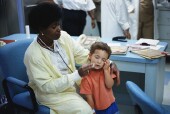
SATURDAY, April 28 (HealthDay News) — Even when they report severe pain, black children and teens are less likely than white youngsters to receive medication for abdominal pain when they’re treated in U.S. emergency departments, a new study finds.
Researchers analyzed 2006-2009 national data on nearly 2,300 patients younger than age 21 with abdominal pain who were seen at an emergency department. Fifty-three percent of patients were white, 23 percent were black and 21 percent were Hispanic.
“The emergency department serves as our nation’s health-care safety net, where all children can receive care regardless of their insurance status, ability to pay or race,” study lead author Dr. Tiffani Johnson, a pediatric emergency medicine fellow at Children’s Hospital of Pittsburgh and a postdoctoral scholar at RAND-University of Pittsburgh, said in an American Academy of Pediatrics news release.
“It is concerning to find that black children are less likely than white children to receive pain medication for treatment of their abdominal pain,” Johnson said.
The researchers also found that black and Hispanic children were more likely than white children to stay in the emergency department for more than six hours. However, there were no racial differences in what tests were conducted to determine the cause of abdominal pain or in how many of these children were admitted to the hospital.
The study was scheduled for Saturday presentation at the Pediatric Academic Societies annual meeting in Boston.
“All children deserve equal access to high-quality health care,” Johnson said. “Identifying racial differences in the care of children is an important first step in improving the quality and equity of care that children receive in the emergency department. We need to do more research to help understand why these differences exist.”
The data and conclusions of research presented at medical meetings should be viewed as preliminary until published in a peer-reviewed journal.
More information
The American College of Emergency Physicians outlines when people should go to the emergency department.

